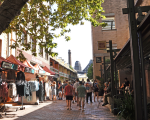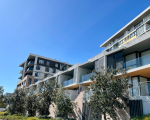As Sydney continues to expand with new developments, high rises, and infrastructure, something remarkable is happening in the background, native wildlife is adapting and, in some cases, thriving in the urban environment. From the brushtail possums nesting in suburban roofs to powerful owls hunting in inner city parks, Sydney is home to an impressive variety of native species.
The question is: how do we ensure they’re protected while our city evolves?
This article explores the hidden world of Sydney’s urban wildlife, what’s being done to protect it, and how you can help support biodiversity in your own backyard.
Sydney Urban Wildlife: Native Animals in the Heart of the City
You might not always see them, but native species live among us. Even in some of Sydney’s busiest areas. The Eastern Water Dragon can be spotted sunbathing along the shores of Darling Harbour, while flying foxes roost in the trees of Centennial Parklands. Meanwhile, native birds like the rainbow lorikeet, sulphur crested cockatoo, and kookaburra fill our suburbs with sound and colour.
In bushier areas like Ku-ring-gai, Lane Cove National Park, and parts of the Sutherland Shire, echidnas, bandicoots, and swamp wallabies are still regularly seen. Yet even in densely populated zones like the Inner West or North Sydney, wildlife corridors and green spaces provide refuge for native species.
Even some of Sydney’s beaches and foreshores, such as those in Manly and Cronulla, are home to nesting shorebirds and hidden ecosystems that thrive just beyond the surf.
The Role of Urban Green Spaces
 Sydney’s network of parks, waterways, and national parks acts as an ecological lifeline. According to the NSW Department of Planning and Environment, more than 60% of Greater Sydney is made up of green infrastructure. Including bushland, urban forests, parklands, and wetlands. These pockets of greenery serve as vital habitat, food sources, and shelter for animals in urbanised zones.
Sydney’s network of parks, waterways, and national parks acts as an ecological lifeline. According to the NSW Department of Planning and Environment, more than 60% of Greater Sydney is made up of green infrastructure. Including bushland, urban forests, parklands, and wetlands. These pockets of greenery serve as vital habitat, food sources, and shelter for animals in urbanised zones.
Initiatives like the Urban Greening Strategy, launched by the City of Sydney, aim to increase green cover by 40% by 2050. These projects not only benefit wildlife but also improve human well being, reduce urban heat, and enhance air quality, making Sydney a more liveable city for everyone.
Programs such as the Greening Our City grant also provide funding for councils, schools, and local groups to plant more trees and create biodiverse spaces that support both people and animals.
Threats to Urban Wildlife
Despite the success stories, urban wildlife still faces growing challenges. Habitat fragmentation, road traffic, pollution, and introduced species (like foxes and domestic cats) all take a toll. According to the Australian Wildlife Conservancy, Australia has the highest rate of mammal extinction in the world, and urban sprawl is a contributing factor.
One particular concern is the Western Sydney Aerotropolis development, which has sparked debate over its potential impact on Cumberland Plain Woodland and the species that rely on it. While developments bring economic growth, they often threaten crucial habitats unless well managed.
Climate change also plays a role. Sydney now faces more frequent heatwaves, bushfires, and storms can disrupt breeding cycles, reduce food availability, and force animals to migrate further into urban spaces, increasing their risk of injury or death.
Wildlife Friendly Infrastructure
The good news? Sydney is increasingly adopting wildlife conscious urban planning. Examples include:
- Fauna overpasses and underpasses in areas like the Northern Beaches and the Blue Mountains to help animals cross roads safely.
- Nest box programs replacing hollow bearing trees that are lost to development.
- Bird safe building design, reducing the number of window strike fatalities among flying species.
- Wetland restoration projects that revive crucial ecosystems and attract everything from frogs to migratory birds.
In Parramatta Park, for example, wildlife cameras recently recorded native long nosed bandicoots returning to areas where they had long been absent, a hopeful sign of the success of restoration efforts.
Even small details like retaining tree canopies during street upgrades or installing ‘frog hotels’ in local reserves can have a big impact on the survival of native species in urban areas.
What You Can Do at Home
 Even if you live in a unit block or small house, you can help create a more wildlife friendly Sydney. Here are some easy steps to take:
Even if you live in a unit block or small house, you can help create a more wildlife friendly Sydney. Here are some easy steps to take:
- Plant natives: Grow local plants like grevillea, bottlebrush, or kangaroo grass to attract birds, bees, and butterflies.
- Install a bird bath or bee hotel to support pollinators and local birds.
- Avoid pesticides and weedkillers that can harm beneficial insects or poison the food chain.
- Keeping cats indoors, especially at night, is a major step in protecting birds and small mammals.
- Support local conservation groups like WIRES or Sydney Wildlife Rescue by volunteering, donating, or spreading awareness.
- Create shelter spots by leaving small brush piles or installing nesting boxes for possums and microbats.
The more habitat we can provide, even in a courtyard or balcony, the more we reduce the pressure on our wild neighbours.
Local Conservation Success Stories
Across Sydney, there are plenty of inspiring examples where local efforts have made a visible difference. In Sydney Olympic Park, years of ecological restoration have turned degraded land into thriving habitats now home to over 250 native animal species, including endangered frogs and birds. The park’s mangrove boardwalks also serve as important educational tools for residents and school groups, showing how humans and nature can coexist.
Similarly, Bushcare volunteer programs, run by councils across the region, are empowering residents to take hands on action in restoring natural areas. By removing invasive weeds, planting native flora, and maintaining walking trails, these groups play a crucial role in protecting biodiversity and preventing further environmental degradation, all while building stronger community ties.
Even small local wins, like the return of frogs to newly restored wetlands in Marrickville or the protection of a microbat colony in Glebe, are signs that conservation works, especially when people come together at a grassroots level.
Wildlife Is Closer Than You Think
Next time you walk through your neighbourhood or local park, take a moment to look and listen, chances are, you’re not alone. Whether you spot a cockatoo perched on a power line, a skink darting through your garden, or a possum rustling overhead at night, these everyday encounters highlight the vibrant, often overlooked Sydney urban wildlife sharing our neighbourhoods.
And as Sydney continues to evolve, our greatest opportunity lies in making sure those creatures are part of the story, not just of the past, but the future. Building a greener Sydney isn’t just about aesthetics. It’s about coexistence, resilience, and responsibility.













